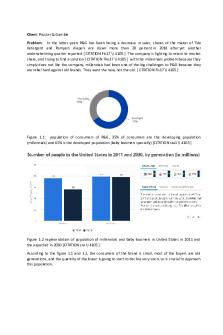Marketing research PDF

| Title | Marketing research |
|---|---|
| Author | Byun Mihwa |
| Course | Business and Marketing Writing |
| Institution | Niagara College Canada |
| Pages | 2 |
| File Size | 148.9 KB |
| File Type | |
| Total Downloads | 18 |
| Total Views | 171 |
Summary
Marketing & Management Program...
Description
Market Research Definition: market research is the process of systematically collecting, recording and analysing information concerning a specific marketing problem.
Information collected must be relevant to the issue or problem being investigated. Information is useful if it: • • •
Results in marketing strategies that meet the need of the business target market Assist the business to achieve its marketing objectives May be used to increase sales and profits.
Marketing data: refers to the information relevant to the defined marketing problem. Primary data: are the fact and figures collected from sources for the purpose of the specific research problem. The main advantage of primary data is that their collection is directed at solving a specific marketing problem. Their main function is to find out exactly what the customer is thinking.
The main methods, which are used to gather primary data: • The survey method: Conducting a survey means gathering data by asking or interviewing people. This may be carried out by:
§ Personal interviews § Focus groups § Electronic methods of collection § Questionnaires The main benefit of a survey is that it gathers first-hand information that provides details of customer’s opinions. However, gathering information through surveys is becoming more difficult because respondent rates are declining. Companies are using electronic methods to collect information about consumer behaviours, due to this decline. • The observation method: Involves recording the behaviour of customers. Non-interviews are involved and direct contact with respondents is avoided. Instead, the actions of the customers are systematically observed. This can raise serious ethical issues, especially with regard to privacy. Information may be gathered through: § Personal observation § Electronic observation This method has become very popular over recent years. It is now possible for a business to access its loyalty program, customer spending habits and customer database all at once, through the use of smart cards and bar coding. The main limitation is that they explain only what happens, not why it happens. • The experiment method: involves gathering data by altering factors under tightly controlled conditions to evaluate cause and effect. Market researchers do this to determine whether changing one of the factors (cause) will alter the behaviour of what is being studies (the effect). The experiments carried out are called test marketing. Secondary data: Is information that has already been collected by some other person or organisation The two sources of secondary data, these include: • Internal data: This is information that has already been collected from internal sources – that is, from inside the business. Such data include customer feedback, sale and management reports and research reports. • External data: this is published data from sources outside the business. Includes magazine, industry association newspapers, and Internet sources. The best know are the numerous reports produced by the Canadian Bureau of Statistics (CBS) Statistical interpretation analysis: Is the process of focusing on the data that represents average, typical or deviations from typical patterns. The first step in drawing conclusions (analysis and interpretation) is to ablate the data. à Display the information in table format. Cross-tabulation will allow comparisons to be made between individual categories. The interpretation will largely be based on the marketing manager’s judgement, experience and intuition....
Similar Free PDFs

Marketing Research
- 48 Pages

marketing research
- 3 Pages

Marketing research
- 2 Pages

Wawa Mintel Research Marketing
- 2 Pages

Marketing Research QUIZ 1
- 11 Pages

Chapter 10 Marketing Research
- 8 Pages

Resumen 10 - Marketing Research
- 7 Pages

Marketing Research Module-1
- 22 Pages

Marketing Research Proposal
- 17 Pages

Marketing research report conclusion
- 27 Pages

Marketing research report n2
- 3 Pages

Chapter 9 - Marketing Research
- 10 Pages

Resumen 9 - Marketing Research
- 2 Pages
Popular Institutions
- Tinajero National High School - Annex
- Politeknik Caltex Riau
- Yokohama City University
- SGT University
- University of Al-Qadisiyah
- Divine Word College of Vigan
- Techniek College Rotterdam
- Universidade de Santiago
- Universiti Teknologi MARA Cawangan Johor Kampus Pasir Gudang
- Poltekkes Kemenkes Yogyakarta
- Baguio City National High School
- Colegio san marcos
- preparatoria uno
- Centro de Bachillerato Tecnológico Industrial y de Servicios No. 107
- Dalian Maritime University
- Quang Trung Secondary School
- Colegio Tecnológico en Informática
- Corporación Regional de Educación Superior
- Grupo CEDVA
- Dar Al Uloom University
- Centro de Estudios Preuniversitarios de la Universidad Nacional de Ingeniería
- 上智大学
- Aakash International School, Nuna Majara
- San Felipe Neri Catholic School
- Kang Chiao International School - New Taipei City
- Misamis Occidental National High School
- Institución Educativa Escuela Normal Juan Ladrilleros
- Kolehiyo ng Pantukan
- Batanes State College
- Instituto Continental
- Sekolah Menengah Kejuruan Kesehatan Kaltara (Tarakan)
- Colegio de La Inmaculada Concepcion - Cebu


